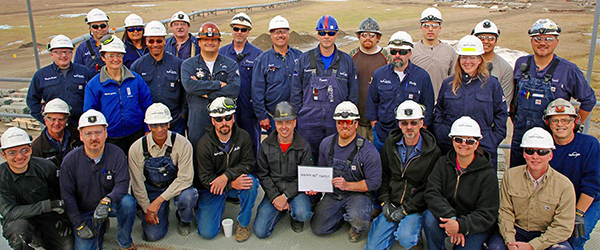2007: Operations Control Center moves from Valdez to Anchorage
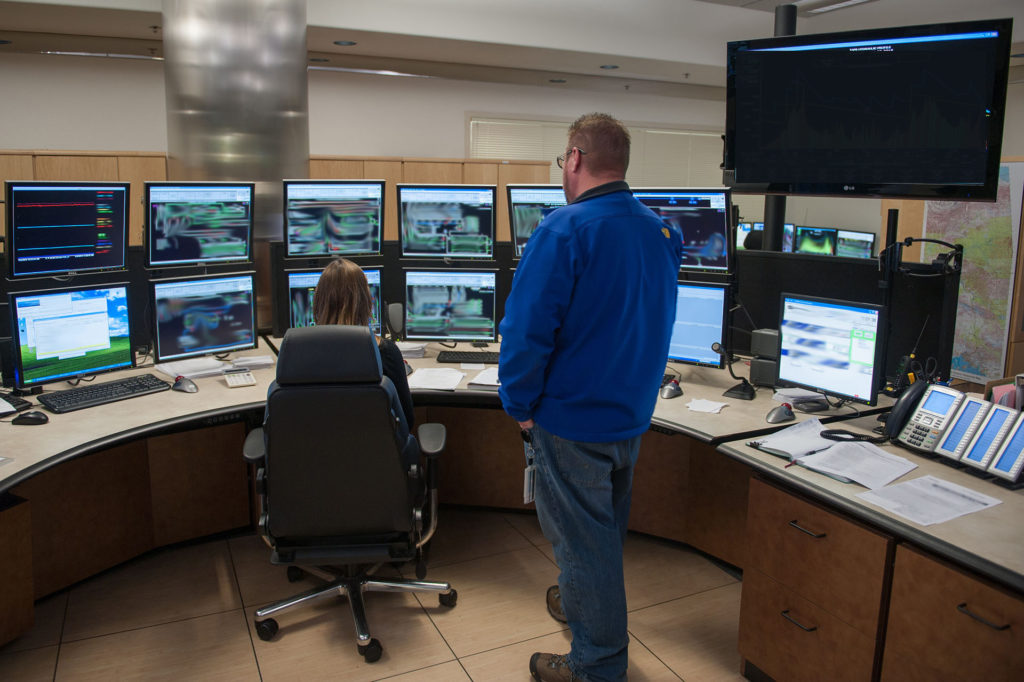 The Operations Control Center (OCC) is the brains of the pipeline, a nucleus where round-the-clock controllers have eagle eyes and ears on alarms, valves, pipeline pressure, tanks, and every other indicator and measure of operations one can imagine. For years now, the OCC and its team have operated in Anchorage. But for decades after startup, the Valdez Marine Terminal was home.
The Operations Control Center (OCC) is the brains of the pipeline, a nucleus where round-the-clock controllers have eagle eyes and ears on alarms, valves, pipeline pressure, tanks, and every other indicator and measure of operations one can imagine. For years now, the OCC and its team have operated in Anchorage. But for decades after startup, the Valdez Marine Terminal was home.
Many current OCC team members worked at the original location: the Terminal building sat above A Road, between the Emergency Response Building and the West Metering facility. It enjoyed incomparable views, but also a leaky ceiling, and supporting infrastructure was insufficient to upgrade control systems. Many saw synergies and sense in placing the pipeline’s operations epicenter closer to headquarters in Anchorage. In the early 2000s, a plan to move the facility to Anchorage began to unfold.
The OCC move was physical and cultural. The move of an entire team and facility marked one of the most significant infrastructure changes in TAPS’ operating history. While the final cutover occurred in 2008, 2007 saw the bulk of the work, building, testing, and employee relocating.

Some may recall the effort as being bundled up with Strategic Reconfiguration – also called “SR,” “Electrification and Automation,” or “E&A.” That multiyear effort to upgrade pump stations was related in that both scopes depended on SCADA system upgrades, but the two were separate pieces of work, said Rod Mitchell, who at the time worked with the Instrumentation team in Valdez at the OCC facility.
“Phil Doherty and I had just helped with installing the new SCADA system up and down the pipeline, which was a precursor to letting OCC move from the communications hub of Valdez and the precursor to doing Strategic Reconfiguration,” Rod said. “We all knew that, with the new SCADA system, OCC could operate from literally anywhere in the world.”
For this retrospective on 2007, the following individuals shared memories of work to relocate the OCC.
- Rod Mitchell, who was an Instrumentation team member
- Eliza Tiulana and Kevin Eldridge, OCC Senior Controllers in Valdez who worked on the move
- Scott “Chip” Conroy, who had just recently started as an OCC controller, after transferring from a role of Pipeline Operations Technician at Pump Station 1
- Mark Dahl, one of four OCC supervisors at the time
- Kathy LaForest, who worked (and still does!) in Human Resources
There were factors driving the OCC relocation.
Kevin: There were several drivers for moving OCC, and the biggest one was the building needed to be replaced. The roof leaked and had some structural damage. The building we were in had reached the end of its life.
Rod: In heavy snow years – and there were a lot – they would wash the snow off of the roofs of the Valdez OCC from the firewater system on Terminal. Roy Hansen had put a special “snow load” measuring device: it was a tape measure mounted to the ceiling in the HVAC room. It would show the sag of the roof. It had special markings every few inches, with the most extreme saying “RUN!” when we hit 12 inches of sag.
Kevin: One year, a controller went back in the server room after a typical Valdez snowstorm and the tape measure had pushed down about an inch below the shovel roof mark. They called the engineer to report it and he said, “Run like hell!” The SCADA Tech drew a new line on the wall at the bottom of the tape measure and labeled it, “Run like hell.”
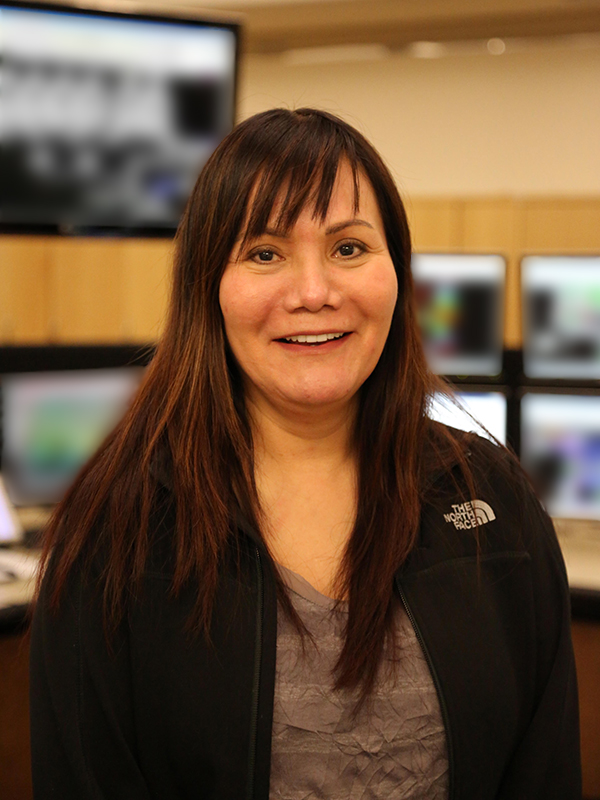
Eliza: We needed a new OCC and there many changes that were going to be happening where we were going to need more support personnel. When it rained in Valdez, and it rained a lot, we had to place trash cans where the roof was leaking. There was a leak near a smoke room that was next to the pipeline console. One day, it was raining and one of the controllers had the “smoke room” door open and as he was smoking he was blowing the smoke back into the smoke room and rain was leaking into the bucket. Needless to say, we needed a new control room!
While the cutover to Anchorage-based OCC operations wasn’t official until 2008, major deliverables in 2007 laid the groundwork for the relocation.
Kevin: I arrived at the new facility in early June 2007 with several of my coworkers who were also testing the new control system software. We were working on the floor beneath the new OCC in a warehouse storage area, surrounded by chain-link fencing from floor to ceiling, and a locking gate. We called it “the cage.”
Eliza: We spent months down there testing control systems. All that control systems had to be locked and secured, hence the locked cage area.
Kevin: Above us they were drilling and cutting and making all kinds of racket building the new control center. When I got here they were just putting the metal studs up for the walls and the cable trays in for the control room. My involvement included everything from project meetings, helping to pull wires into the control room, setting up offices to testing the control consoles, and taking control from Valdez and operating TAPS from Anchorage. Most of my day was spent downstairs testing the new control system software.
Eliza: Every point and alarm had to be checked and there were literally thousands and thousands of points and alarms that had to tested by a SCADA analyst and fully qualified controller. After the testing was completed, Kevin, Goodman Patrick and I were assigned as the controllers along with Mark Dahl, who was the OCC Supervisor on-shift, to take control in Anchorage. There were countless hours of work and preparations leading up to that day so it went off without a hitch. It speaks volumes about the many people who put in the work to ensure that the transfer of operations was done safely and without incident.
In 2007, the Anchorage OCC began operating TAPS during days and shifting back to Terminal OCC control at night.
Rod: Having dual locations for a time was complex, but the new SCADA system allowed for having multiple operating locations.
Mark: Since start-up in 1977, OCC had always remotely operated the pump stations, so it wasn’t really anything new to operate the Terminal remotely. I recall that there were some concerns about us not being on-site, as well as no longer being co-located with some communication equipment. But the transition was smooth and I think Valdez personnel soon became adjusted. We were able to switch back and forth until we were satisfied with remaining in control from Anchorage.
Kevin: Technology had changed significantly since the mid-1970s and the OCC no longer needed to be hardwired to the pipeline or its terminus in Valdez. Once fiberoptic was in place along the pipeline, it was a game-changer. OCC could’ve been located at Pump 1, Fairbanks, Valdez, Anchorage, anywhere there was a network connection big enough to support the data traffic. Nothing really changed at all for work duties. The biggest change was we lost our face-to-face interaction with the Terminal team, we no longer got morning visits from the crew discussing work permits that day. And we lost our million-dollar view. We no longer had a window to tell what the weather was doing or a view to reset our psyche after an operational upset.
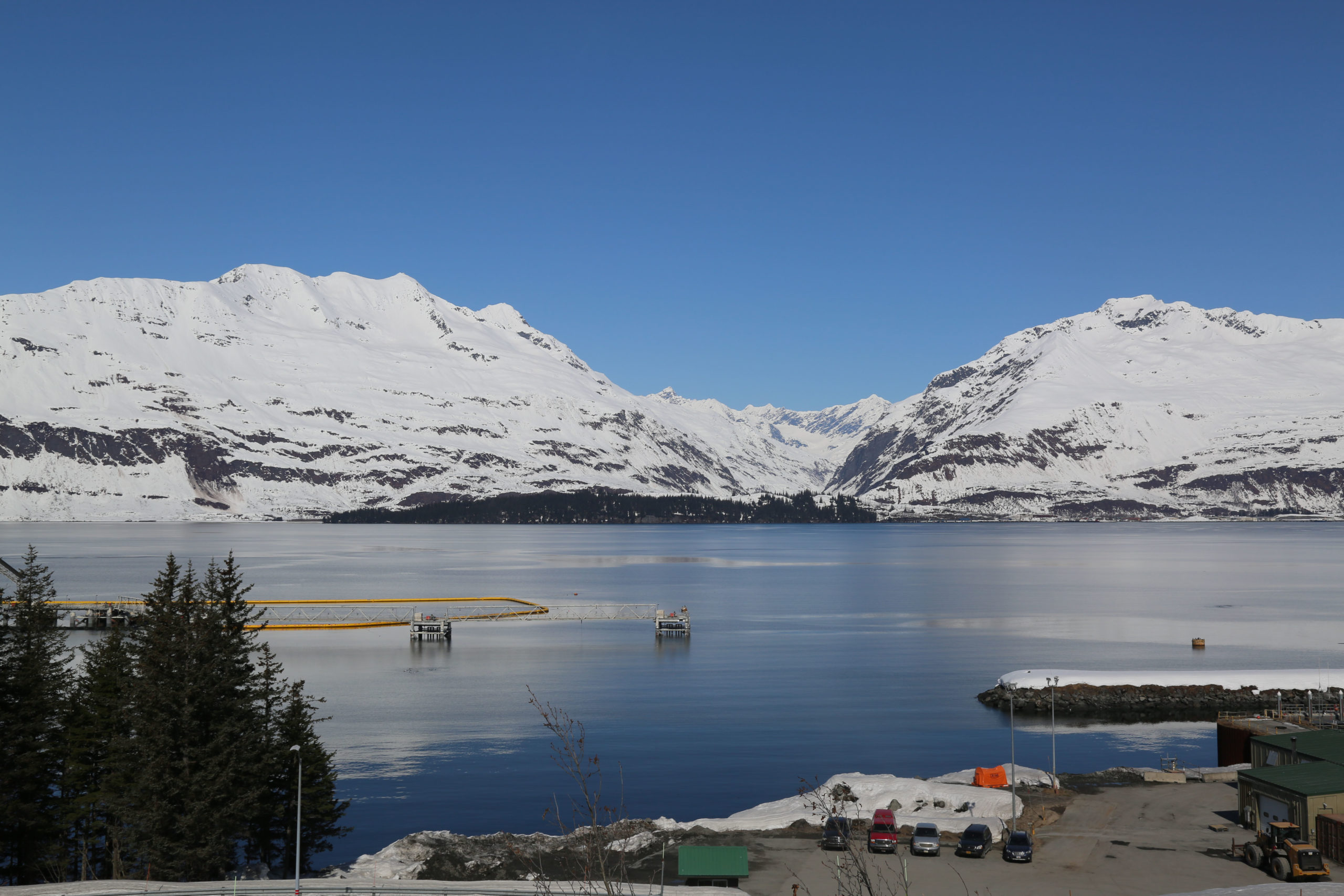
Many recall that stellar view from the original OCC.
Eliza: There were windows that covered the whole wall that faced the water and mountains. On nice days, it was a world-class view.
Mark: There were glass windows that separated the control room from a hallway where visitors came, and we sometimes felt like we were animals in a zoo to be observed.
Chip: What I remember and miss the most is the view from the control room window that looked out over the berths, the Port of Valdez and the beautiful mountains. Watching a tanker make its turn and pull into the berth with the scenery around it is so cool.
Kevin: It had a million-dollar view of the port and the mountains. You could look out and see the tankers approaching, loading on the berths and leaving. You could watch the fishing fleet and cruise ships in the summer. In the winter, you could watch the snow fall and toward the end of it you’d look for the wolf’s shadow on the mountain across the port signaling spring was around the corner. It was an awesome place to work.
While the new facility was lacking in natural ambiance, it made up ground in other areas.
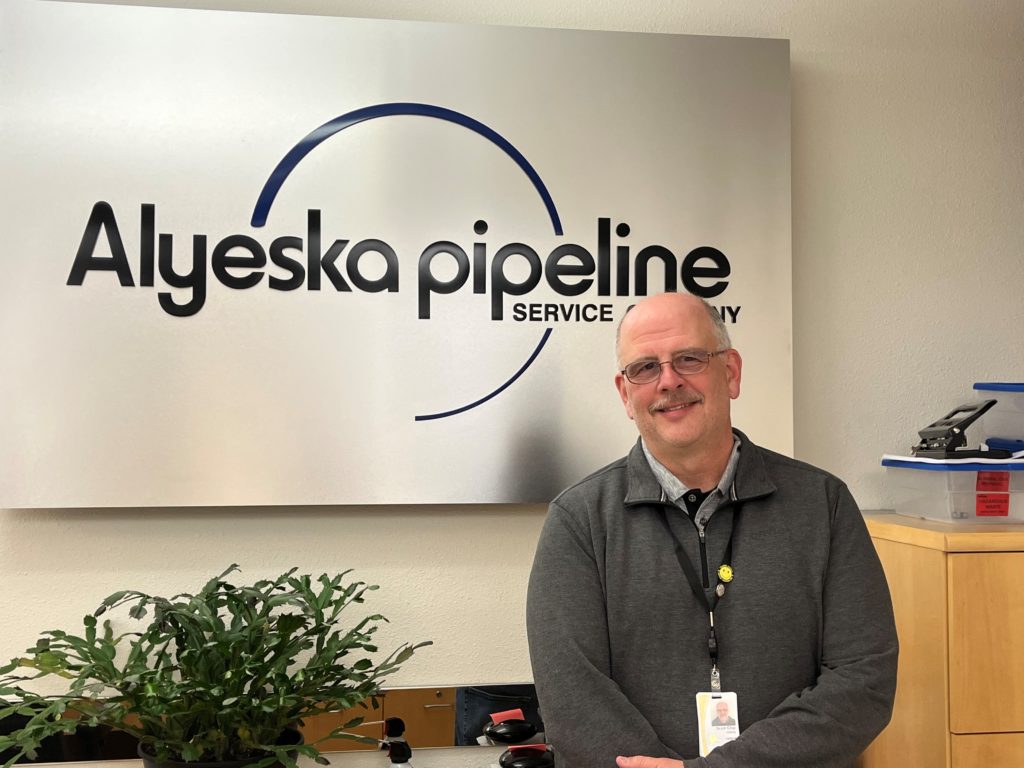
Chip: From my perspective, it allowed more folks to have access to OCC. This includes both TAPS employees and others. From an operations standpoint, having the support staff for OCC such as SCADA, Automation and others right here in our building, which I believe adds to the efficiency of OCC.
Rod: Back then, OCC was just the Operations Center and only that staff. Even the technicians were loaned from a different group that did not report to OCC. Engineers were in Anchorage, with the hydraulic engineer being their most relied-on resource. Now there is a whole slew of support personnel at OCC: Operations Engineering, with the hydraulic engineer having their own office here; SCADA support and automation support, both under Operations engineering; and also networking and hardware support having offices here.
Kevin: At the time the new OCC was built, it was state-of-the-art for control rooms. It took into account ergonomics with adjustable control consoles, environmental issues with type, placement and control of lighting, room temperature control at each console, white noise, and support staff located just outside the control room. It was forward-thinking for its day.
Eliza: You could adjust the lighting. The ergonomics, the consoles that went up and down as needed. It was a breath of fresh air to come to an upgraded control room.
Mark: The move to Anchorage positioned us well for full implementation of SR. OCC always controlled pumps and oil movement down the pipeline, but SR brought control of many other pump station systems, particularly power generations, to OCC. It greatly increased the complexity of the OCC controller’s job. The attraction of the location also aided in recruiting the next generation of high performers in the OCC and in the SCADA and automation realms.
As with any major infrastructure change, the OCC relocation from Valdez to Anchorage meant relocating people and jobs, too.
Mark: A good number of people had to be relocated over time and those moves were expertly handled by our HR Generalist, Kathy LaForest. I can’t say enough good things about Kathy – these transitions involved everything from moving expenses to home sales, for a group of people already under considerable stress from the job transition.
Kathy: I think the biggest logistical challenge was the duration of the transition, with OCC employees in Anchorage immediately for the design and build, and testing of the new OCC, and others fully transferring I think almost two years later. The OCC team demonstrated exceptional leadership and communication throughout the project phases. I am pretty sure every single person on the HR team was involved at some point along the way and I am grateful to them all, the team then, the team now.
Teamwork is credited for the ultimate success of the relocation project.
Chip: We are so fortunate to have such terrific and talented individuals supporting OCC.
Kathy: To make sure I was keeping everything straight, it became an opportunity to talk with OCC team members multiple times and these conversations were a highlight for me throughout the project. They kept a non-stop focus on the project while never losing sight of the impact to the entire team, making sure to support each other.
Mark: The OCC team in Valdez was much the same as it is today in terms of being a close-knit group of high-performing individuals.
All the hard work in 2007 and prior paid off: a Jan. 15, 2008, KYP announced parallel operations were underway, following “several months of functional check out and site acceptance testing performed on all communications, networks, control systems and applications necessary to safely operate and control TAPS from the new control center.” A Feb. 5, 2008, KYP told the workforce the OCC was entering its third week of successful 24/7 operations “and is meeting our expectations for performance and reliability.”
READ MORE 45TH ANNIVERSARY THE EVOLUTION OF TAPS STORIES:
1991: Atigun Pass mainline reroute
2013: With straight pipe installed, PS10 demobilization complete


